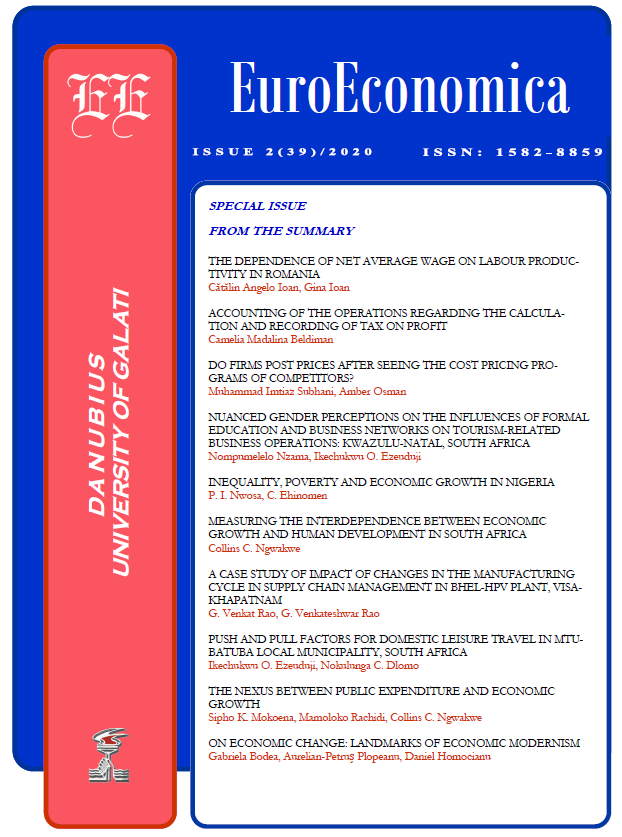Do Firms post Prices after seeing the Cost Pricing Programs of Competitors?
Keywords:
Market price; cost price; high involvement products; low involvement products; substitute brands; pricing behavior model; ARDL ModelAbstract
The price tag on any product has always been enticing to customers irrespective of the era and is a key factor in the purchase intention decision. Pricing behavior incorporates strategies to position the brand in the market. This paper explored whether the pricing strategy (setting market price) of a firm is determined by its own production cost for a product or by the cost pricing programs of other firms (competitors). It found that the pricing strategy for a product varies among firms. The findings confirmed that for high involvement substitutes, the pricing behavior of a firm mainly depends on its own production cost, in contrast to low involvement substitutes. The AR(1) process is present in the series of market prices for both of the HI substitutes, which reflects that pricing programs for HI substitutes for current and future periods also rely on their pricing history. The AR1-process was reversed for LI substitutes.
References
Alles, M. & Datar, S. (1998). Strategic transfer pricing. Management Science, 44, pp. 451-461. doi:10. 1287/mnsc. 44. 4. 451.
Banker, R. D. & Hughes, J. S. (1994). Product costing and pricing. The Accounting Review, 69, pp. 479-494.
Carvalho, M. (2009). Price recall, Bertrand paradox and price dispersion with elastic demand. Netherlands: Tilburg University. Working Paper No. 2009-69. doi:10. 2139/ssrn. 1470716.
Cin, M. F. (2005). Industrial Price determination process in the Turkish Private Manufacturing industry between 1980 and 2000: A Keynesian approach. Journal of Post Keynesian Economics, 27, pp. 491-505.
Dale, K. (1995). Manufacturing: A wide product range at a low cost. Industrial Management & Data Systems, 95, pp. 8-11. doi:10. 1108/02635579510086670.
Damay, C. ; Guichard, N. & Clauzel, A. (2011). When children confront prices: An approach based on price presentation. Journal of Product and Brand Management, 20, pp. 514-525. doi:10. 1108/10610421111181822.
Frederiksen, J. (2011). Broadband access, regulatory issues and profitability analyses. Info, 13, pp. 19– 28. doi:10. 1108/14636691111160617.
Grewal, D. ; Roggeveen, A. L. ; Compeau, L. D. & Levy, M. (2011). Evolving pricing practices: The role of new business models. Journal of Product & Brand Management, 20, pp. 510 – 513. doi:10. 1108/10610421111181813.
Indounas, K. & Avlonitis, G. (2011). New industrial service pricing strategies and their antecedents: Empirical evidence from two industrial sectors. Journal of Business & Industrial Marketing, 26, pp. 26–33. doi:10. 1108/08858621111097184.
Kachaner, N. ; Lindgardt, Z. & Michael, D. (2011). Innovating low-cost business models. Strategy & Leadership, 39, pp. 43-48. doi:10. 1108/10878571111114464.
Kaplan, R. (1982). Advanced management accounting. Englewood Cliffs, NJ: Prentice Hall.
Lal, R. & Staelin, R. (1984). An approach for developing an optimal discount pricing policy. Management Science, 30, 1524-1539. doi:10. 1287/mnsc. 30. 12. 1524.
Mazumdar, T. (1986). Experimental investigation of the psychological determinants of buyers’ price awareness and a comparative assessment of methodologies for retrieving price information from memory. Virginia Polytechnic Institute and State University. Working Paper.
Monroe, K. B. (1990). Pricing: Making profitable decisions. New York, NY: McGraw-Hill.
Monroe, K. B. & Krishnan, R. (1985). The effect of price on subjective product evaluations perceived quality. In J. Jacoby, & J. Olson (Eds. ), Perceived quality: How consumers view stores and merchandise (pp. 209-232). Lexington, MA: Lexington Books.
Noble, P. M. & Gruca, T. S. (1999). Industrial pricing: Theory and managerial practice. Marketing Science, 18, 435-454. doi:10. 1287/mksc. 18. 3. 435.
Richards, T. J. & Patterson, P. M. (2005). Retail Price fixity as a facilitating mechanism. American Journal of Agricultural Economics, 87, 85-102. doi:10. 1111/j. 0002-9092. 2005. 00704. x.
Roy, A. ; Hanssens, D. M. & Raju, J. S. (1994). Competitive pricing by a Price Leader. Management Science, 40, pp. 809-823. doi:10. 1287/mnsc. 40. 7. 809.
Rushdy, F. & Lund, P. J. (1967). The effects of demand on prices in British manufacturing. Review of Economic Studies, 34, pp. 361-373.
Shehryar, O. & Hunt, D. M. (2005). Buyer behavior and procedural fairness in pricing. Journal of Product & Brand Management, 14, pp. 1-14.
Swani, K. & Yoo, B. (2010). Interactions between Price and P. Deal. Journal of Product and Brand Management, 19, pp. 143-152. doi:10. 1108/10610421011033494.
Yun, W. & Moon, I. (1998). Warranty cost analysis under continuous sales. The Journal of the Operational Research Society, 49, pp. 176-178.
Zeithaml, V. A. (1988). Consumer perceptions of price, quality, and value: A means-end model and synthesis of evidence. Journal of Marketing, 52, 2-22. doi:10. 2307/1251446.
Published
How to Cite
Issue
Section
License
The author fully assumes the content originality and the holograph signature makes him responsible in case of trial.


